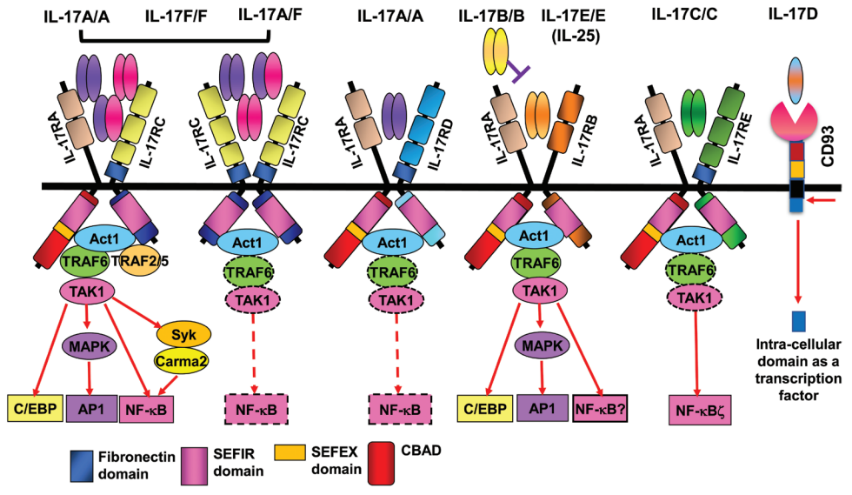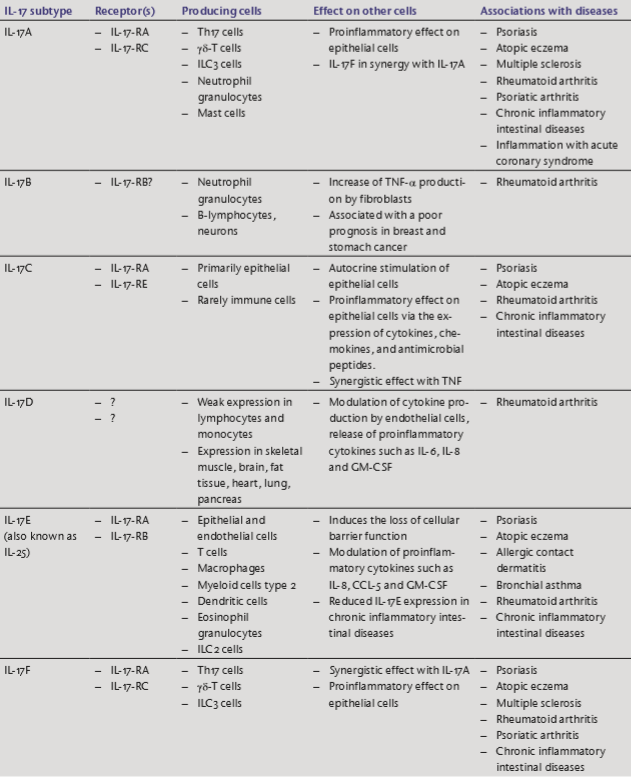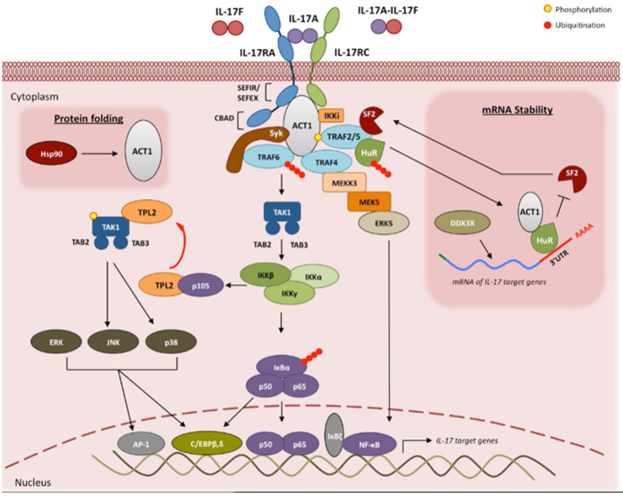Unraveling the IL-17 Family and its Receptor Complex: Key Players in Immune Responses
Autoimmune disease target - IL-17 Family
IL-17 plays an important role in promoting autoimmune diseases such as psoriasis, psoriatic arthritis, and ankylosing spondylitis (AS). Currently, five large-molecule biopharmaceuticals targeting IL-17/IL-17R are available worldwide, including four IL-17 monoclonal antibodies and one IL-17RA monoclonal antibody, namely Secukinumab(Novartis), Ixekizumab(Eli Lilly), Netakimab(Biocad), Brodalumab(Kyowa Hakko Kirin), and Bimekizumab(UCB).
The enthusiasm for developing IL-17/IL-17R antibody drugs is closely related to the biological function of IL-17. The IL-17 family ligands have six subtypes: IL-17A, IL-17B, IL-17C, IL-17 D, IL-17E (also called IL-25), and IL-17F. IL-17A and IL-17F form homodimers and heterodimers, while IL-17B, IL-17C, and IL-17E form homodimers [1]. The IL-17R family includes 5 receptor subunits, IL-17RA, IL-17RB, IL-17RC, IL-17RD, and IL-17RE. IL-17RA is the earliest discovered receptor member of the IL-17R family and is a common receptor for several other IL-17 family ligands [2]. IL-17 ligands produce organ-specific pro-inflammatory or anti-inflammatory responses through their corresponding receptors.
IL-17 Ligand Family

Figure 1. The IL-17 cytokine and its receptor family[1]
IL-17A
IL-17A plays a core role in the pathogenesis of psoriasis, and the inhibitory antibodies currently used to treat this disease are mainly aimed at this target. It acts on non-hematopoietic cells, especially epithelial cells, and plays an important role in the immune response in neighboring organs. In the skin, IL-17A causes changes in keratinocyte proliferation and differentiation and induces antimicrobial peptides and chemokines. IL-17A also has a role in other inflammatory diseases. In patients with multiple sclerosis (MS), rheumatoid arthritis, and acute coronary syndrome, the increase in IL-17A concentration is associated with systemic inflammation parameters [3].
IL-17F
IL-17F and IL-17A are encoded by the same gene locus (6p12), and their regulation is similar. IL-17F can form heterodimers with IL-17A. In psoriasis patients, the content of IL-17F in plaques is higher than that in unaffected skin areas. Studies show that IL-17F and IL-17A have a synergistic effect: unlike inhibiting IL-17A alone, inhibiting these two cytokines at the same time can significantly increase the down-regulation of inflammatory mediators in skin and joint fibroblasts. In bacterial or fungal infections, the function of IL-17F and IL-17A is similar [3].
IL-17B
The role of IL-17B in psoriasis is not clear, and it is only weakly expressed in psoriatic lesions. IL-17B is not produced by activated T lymphocytes, but IL-17B has been found in neutrophils, B cells, neuronal cells, stromal cells, and colon epithelial cells. The expression of IL-17B in the synovium and pancreatic tissue of patients with rheumatoid arthritis (RA) increases, and IL-17B enhances the effect of TNF-α in fibroblasts, which may be important for the immune formation.Look at "IL-17 Family Ligands" and "IL-17 Receptor Family" below for full details on IL-17 ligands and receptors.
IL-17D
IL-17D is expressed in many cells and organs, but its expression in immune cells such as lymphocytes and monocytes is weak. IL-17D induces endothelial cells to produce IL-6, IL-8, and GM-CSF. It also has an inhibitory effect on hematopoiesis of bone marrow precursor cells. Other studies suggest that IL-17D is associated with viral and tumor diseases, especially through the recruitment of natural killer cells (NK cells). However, current data regarding IL-17D in the development of tumors are contradictory. In animal models, the absence of IL-17D leads to a higher susceptibility to viruses [3].
IL-17C
IL-17C is not produced by T lymphocytes, but is mainly produced by epithelial cells such as keratinocytes. High concentrations of IL-17C can be detected in human psoriasis plaques. It can act as an autocrine stimulator of epithelial inflammation, especially when combined with TNF-α. Overexpression of IL-17C in keratinocytes causes psoriasis-like dermatitis in mice. IL-17C can also promote the growth of sensory nerves. In a mouse model of skin herpes infection, IL-17C can induce neuronal growth in a manner similar to NGF (nerve growth factor). It has also been reported that in mouse models of psoriasis and atopic dermatitis, the absence of IL-17C significantly reduces the inflammatory response. IL-17C therefore serves as an epithelial stimulant of immune response, operating independently of T cells [3].
IL-17E (IL-25)
IL-17E induces keratinocyte proliferation and can activate innate immune cells. In psoriasis, IL-17E is strongly expressed by keratinocytes and activates specific subtypes of macrophages (M2 or tissue macrophages). The expression of IL-17E in psoriatic lesions is positively correlated with the number of neutrophils and negatively correlated with the number of T lymphocytes. This is surprising because IL-17E has been regarded as a cytokine operating in Th2 immune responses for a long time. Allergic asthma animal models show that inhibiting IL-17E with neutralizing antibodies significantly reduces bronchial hyperresponsiveness, serum IgE concentrations, and histological features in inflammatory responses. Similarly, IL-17E is also strongly expressed in atopic eczema [3].
Like IL-17C, IL-17E seems to amplify inherent inflammatory processes in the skin, independent of the cells of the adaptive immune system [3].
IL-17 Receptor Family
The IL-17R includes five receptor subunits: IL-17RA, IL-17RB, IL-17RC, IL-17RD, and IL-17RE. IL-17RA is the founding member of the IL-17R family and is the common receptor used by several other IL-17 ligands. That is, the IL-17R is composed of heterodimers formed by IL-17RA and ligand-specific subunits (IL-17RB-E), which are widely expressed in epithelial cells. Homodimers or heterodimers of IL-17A and IL-17F bind to receptors composed of RA and RC subunits, but with different affinities. In addition, the receptor composed of IL-17RD and IL-17RA has been identified as an alternative receptor for the IL-17A homodimer. Recent studies show that the IL-17F homodimer has been proven to bind to the IL-17RC homodimer, suggesting the possibility of an IL-17 signaling pathway independent of IL-17RA. IL-17C is recognized by receptors composed of RA and RE subunits, while the IL-17E signaling pathway is mediated by receptors composed of RA and RB subunits. The IL-17B signal is transmitted through an unidentified receptor containing IL-17RB. The receptor for IL-17D is currently unclear. All IL-17 receptors recruit Actin 1 (Act1) as a linking molecule and convey downstream signals through the tumor necrosis factor receptor (TRAF6), mitogen-activated protein kinase (MAPK), and nuclear factor κB (NF-κB) [3].

Figure 2. An Overview of IL-17 Subtypes, Related Receptors, Producing Cells, Impact on Other Cells, and Relationship with Diseases [2]
IL-17 Signaling Pathway
IL-17 signal transduction starts with the binding of IL-17A/A, IL-17A/F, or IL-17F/F cytokines to their receptors IL-17RA and IL-17RC. After ligand binding, Act1 activates several independent signaling pathways mediated by different TRAF proteins. Activation of TRAF6 can trigger NF-κB, C/EBPβ, C/EBPδ, and MAPK pathways. The IL-17R-Act1 complex also binds to MEKK3 and MEK5 through TRAF4, inducing ERK5 activation. TRAF6 and TRAF4 mediated IL-17 signaling pathways can lead to the transcription of inflammatory genes, and the IL-17 signaling pathway controls the stability of IL-17 target gene mRNA through the ACT1-TRAF2-TRAF5 complex. Therefore, IL-17 upregulates the expression of inflammatory genes by inducing de novo gene transcription or stabilizing the transcription of target gene mRNA [2].

Figure 3. IL-17 Signaling Pathway [2]
Beta LifeScience offers over 30 IL-17 series target proteins, suitable for different stages of animal immunity, antibody screening, function evaluation, and quality control.
- Complete Variety: Over 30 target proteins including IL-17A/B/C/D/E/F, IL-17A&17F, and IL-17RA/RB/RC/RD/RE can be selected according to needs;
- Available Labels: His/Fc/Biotin
- High Purity: Verified by SDS-PAGE/SEC-HPLC
- High Activity: Verified by ELISA/BLI/Cell
Reference Data:
Validated by SEC-HPLC:

Greater than 95% as determined by SEC-HPLC. (Cat# BL-0607NP)
Validated by ELISA:

Immobilized Human IL-17RA-Fc(Cat#BL-0006NP) at 2μg/ml (100 μl/well)can bind Human IL-17A-His(Cat#BL-0607NP).The ED50 of Human IL-17A-His(Cat#BL-0607NP) is 0.49 ng/ml.
Validated by BLI:

Loaded Biotinylated Human IL-17RA-Fc(Cat#BL-0006NP) on Pro A Biosensor, can bind Human IL-17A-His(Cat#BL-0607NP) with an affinity constant of 0.003 nM as determined in BLI assay.
Validated by Cell Assay:

Measured by its ability to induce IL-6 secretion by NIH3T3 mouse embryonic fibroblast cells. The ED50 for this effect is 1-10 ng/ml.(Cat#BL-0607NP)
Related Products:
|
Protein |
Product Name |
Cat. No. |
|
IL-17A |
Recombinant Human IL-17A,tag free |
|
|
Recombinant Human IL-17A (C-6His) |
||
|
Recombinant Mouse IL-17A (C-6His) |
||
|
Recombinant Cynomolgus IL-17A (C-6His) |
||
|
IL-17B |
Recombinant Human IL-17B (C-Fc) |
|
|
IL-17C |
Recombinant Human IL-17C (C-6His) |
|
|
Biotinylated Human IL-17C (C-6His-Avi) |
||
|
IL-17D |
Recombinant Human IL-17D,tag free |
|
|
IL-17E |
Recombinant Human IL-25 (C-6His) |
|
|
IL-17F |
Recombinant Human IL-17F,tag free,E.coli |
|
|
Recombinant Human IL-17F,tag free,Human Cells |
||
|
Recombinant Human IL-17F (N-6His) |
||
|
Recombinant Human IL-17F (C-6His) |
||
|
Recombinant Mouse IL-17F (C-6His) |
||
|
Recombinant Cynomolgus IL-17F (C-6His) |
||
|
IL-17A&17F |
Recombinant Human IL-17A&17F (C-6His) |
|
|
Biotinylated Human IL-17A&17F (C-Avi-6His) |
||
|
IL-17RA
|
Recombinant Human IL-17RA (C-6His) |
|
|
Recombinant Human IL-17RA (C-Fc) |
||
|
Biotinylated Human IL-17RA (C-Fc) |
||
|
Biotinylated Human IL-17RA (C-6His-Avi) |
||
|
Recombinant Mouse IL-17RA (C-Fc) |
||
|
IL-17RB |
Recombinant Human IL-17RB (C-6His) |
|
|
Recombinant Human IL-17RB (C-Fc) |
||
|
Recombinant Mouse IL-17RB (C-6His) |
||
|
IL-17RC |
Recombinant Human IL-17RC (C-Fc) |
|
|
IL-17RD |
Recombinant Human IL-17RD (C-6His) |
|
|
Recombinant Human IL-17RD (C-Fc) |
||
|
Biotinylated Human IL-17RD (C-Fc-Avi) |
||
|
Recombinant Mouse IL-17RD (C-6His) |
||
|
Recombinant Mouse IL-17RD (C-Fc) |
||
|
IL-17RE |
Recombinant Human IL-17RE (C-Fc) |
|
|
Recombinant Mouse IL-17RE (C-6His) |
||
|
Biotinylated Human IL-17RE (C-Fc-Avi) |
Reference:
[1] Chung, Soo-Hyun et al. “Interleukin-17 family members in health and disease.” International immunology vol. 33,12 (2021): 723-729. doi:10.1093/intimm/dxab075
[2] Amatya, Nilesh et al. “IL-17 Signaling: The Yin and the Yang.” Trends in immunology vol. 38,5 (2017): 310-322. doi:10.1016/j.it.2017.01.006
[3] Lauffer, Felix et al. “Cytokines of the IL-17 family in psoriasis.” Journal der Deutschen Dermatologischen Gesellschaft = Journal of the German Society of Dermatology : JDDG vol. 18,7 (2020): 675-681. doi:10.1111/ddg.14124












